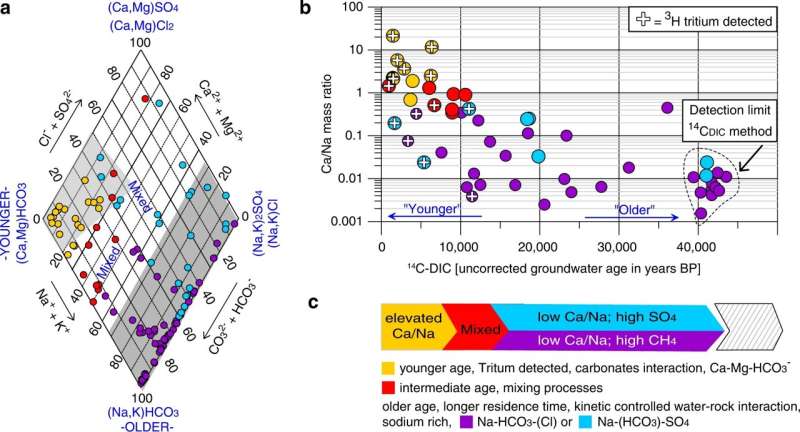This article has been reviewed according to Science X's editorial process and policies. Editors have highlighted the following attributes while ensuring the content's credibility:
fact-checked
peer-reviewed publication
trusted source
proofread
The life below our feet: Team discovers microbes thriving in groundwater and producing oxygen in the dark

Nearly a third of Earth's freshwater resources lie in groundwater—much more than in all lakes, rivers and the atmosphere combined, and exceeded only by the frozen water in polar ice caps. Accordingly, about half of humankind depends on groundwater as a source of drinking water.
Despite the global occurrence and essential importance of groundwater, however, knowledge of the organisms that inhabit it, and how they survive, remains thin.
A recent investigation led by microbial ecologist Emil Ruff of the Marine Biological Laboratory (MBL) has discovered that ancient groundwaters harbor not only diverse and active microbial communities, but also unexpectedly large numbers of microbial cells.
Strikingly, some of these microbes seem to produce "dark oxygen" (in the absence of sunlight) in such abundance that the oxygen may nourish not only those microbes, but also may leak into the environment and support other oxygen-reliant microbes that can't produce it themselves. The study is published today in Nature Communications.
"When doing research, it is common to find surprising results; we just still know very little about the cosmos," said Ruff. "But it is a highlight to find something so utterly unexpected as oxygen that seems to be produced deep beneath our feet in permanent darkness. At first we thought that we had contaminated all our samples, but additional analyses supported a source of the gas within the aquifers."
The study investigated 138 groundwater samples drawn from 14 aquifers that lie beneath more than 80,000 square miles of prairie in the province of Alberta, Canada, an area three times the size of Ireland. The aim was to investigate the biogeochemistry and microbial ecology of a broad range of aquifer environments.
"The leakage of dark oxygen into the groundwaters could have very important consequences relevant for climate change research," said co-author Marc Strous of the University of Calgary. "We have indications that the microbes use the groundwater oxygen to consume methane, a greenhouse gas. Especially in the province of Alberta, methane is common in groundwaters and may leak out of the ground into the atmosphere. We will now seek to understand if and how much methane these microbes prevent from being emitted."
Surprisingly, the team found significantly more microbial cells in older groundwater samples than in younger groundwaters, suggesting these ancient groundwaters have evolved over time to provide energy for microbes to grow. This discovery runs counter to prior studies in subsurface ocean and land ecosystems that found microbial cell density commonly decreases as depth increases, presumably due to energy limitations.
"Counting bacterial cells under a microscope requires enormous patience and skill and is rarely done for large numbers of samples," said Strous. "Yet, when Isabella Hrabe de Angelis joined Dr. Ruff as a project student she did just that, and spent hundreds of hours behind a microscope. It was thanks to this effort that we could show that these groundwaters are actually productive ecosystems, where everybody had expected them to be subsurface 'deserts,' generally devoid of nutrients and energy."
Oxygen or die
Oxygen is vital to life for humans, most animals, and many microorganisms. By far, most oxygen on Earth is produced via photosynthesis, in which plants and microbes use sunlight as an energy source to assimilate carbon dioxide for growth. Because this oxygen isn't all used up by the plants and microbes themselves, over eons it could accumulate in the atmosphere, where it is available to humans and other oxygen-dependent organisms.
There are, however, a few obscure chemical and microbial processes that can produce oxygen in the absence of light. In one case, microbes split nitric oxide into nitrogen and oxygen, and in the other they split chlorite into chloride and oxygen. These processes, also called microbial dismutations, were thought to be very rare and only relevant on a micro scale, with the produced oxygen being immediately consumed.
However, Ruff et. al. found evidence that such oxygen-producing microbes can be very abundant and active in groundwater ecosystems. In fact, so abundant and active that they seem to leak substantial amounts of this "dark oxygen" into their surroundings, causing it to accumulate. Analogous to the accumulation of oxygen in the atmosphere by photosynthesis, this below-ground process may enable microbes that depend on oxygen to survive and thrive.
"Using oxygen for respiration releases a lot of energy that an organism can use to grow and propagate," Ruff said. "It is not surprising that basically all animals that can be seen with the naked eye use oxygen, including insects, mollusks and vertebrates. Without oxygen they could not sustain such large bodies. Similarly, we think that the large numbers of microbes that we find in these groundwaters are sustained via the energy released from using oxygen. This finding challenges our current understanding of Earth's subsurface ecosystems."
Groundwater samples for this study were obtained from the Groundwater Observation Well Network maintained by Alberta Environment and Protected Areas, Canada, which has compiled geochemical data for groundwater from over 250 sampling sites obtained from monitoring wells in different aquifers and regions of Alberta, representing a variety of geochemical regimes and groundwater ages.
More information: S. Emil Ruff et al, Hydrogen and dark oxygen drive microbial productivity in diverse groundwater ecosystems, Nature Communications (2023). DOI: 10.1038/s41467-023-38523-4
Journal information: Nature Communications
Provided by Marine Biological Laboratory



















